 新闻详情
新闻详情
 新闻详情
新闻详情
万双网讯 2025年7月8日上午,一年级全体师生及家长齐聚校园,共同参与了一场别开生面的期末PBL展示暨家长会活动。本次活动旨在通过多元化的展示形式,呈现孩子们本学期的学习成果,同时搭建家校沟通的桥梁,促进学生全面发展。
On the morning of July 8th, 2025, all Grade 1 students, teachers, and parents gathered on campus to participate in a unique end-of-term Project-Based Learning (PBL) presentation and parent meeting. This event aimed to present the children’s learning achievements through diverse presentation formats while building a bridge for communication between the school and parents.
一、图形和英语的魔法世界:数学英语学科PBL成果展
I. The Magical World of Shapes and English: Math & English PBL Exhibition
活动伊始,当家长们步入校园,目光便不由自主地被孩子们精心打造的语数英学科PBL成果展所吸引。各班级的展示区里,孩子们的学习过程和成果被巧妙地呈现出来,充满了童趣与创意。家长们在欣赏孩子们作品的同时,也感受到了孩子们在学习过程中的成长与进步。
As parents entered the campus, they were immediately drawn to the meticulously crafted Math and English PBL exhibitions. Each classroom’s display area showcased children’s learning processes and outcomes with their creativity and childlike charm. While appreciating the children’s work, parents witnessed their children’s growth and progress throughout their learning journey.
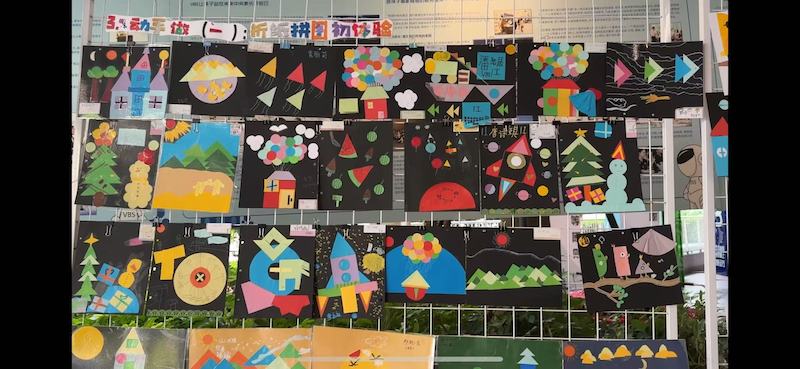
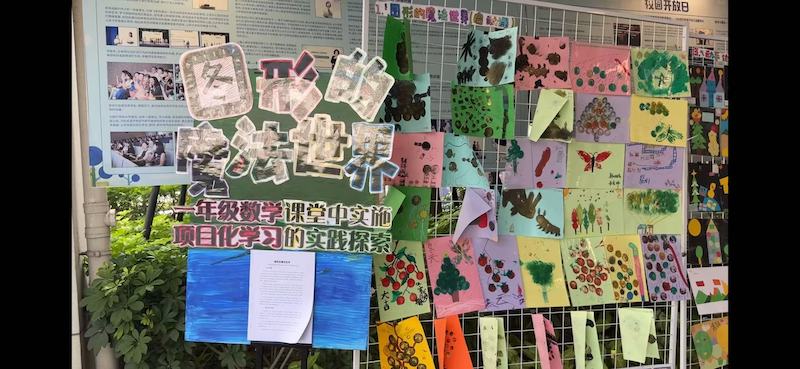
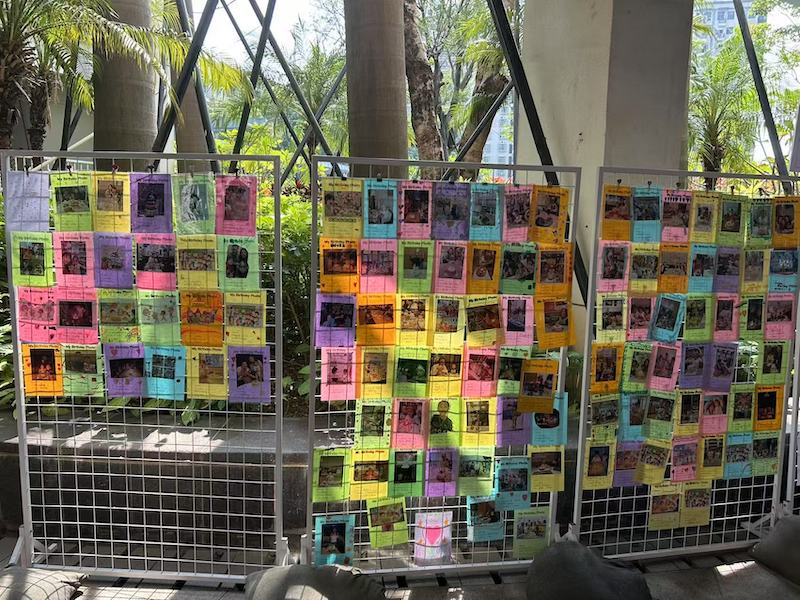
二、Things we like:外教学科PBL成果展示
II. Things We Like: Foreign Teachers’ PBL Showcase
随后,活动移步至剧场,进入“星光璀璨·外教学科 PBL 成果展示”环节。主持人精彩的开场白拉开了序幕,孩子们依次上台进行节目表演,充分展示了他们在外教学科 PBL学习中的收获与风采。
The event then moved to the theater for the “Spotlight: Foreign Teachers’ PBL Showcase.” An engaging opening by the hosts set the stage for the children’s performances, fully demonstrating their achievements and confidence gained through foreign teachers’PBL activities.
首先出场的1X班,在舞台上,孩子们自信表演了一首《I like sing O》,赢得了家长们阵阵掌声。其次出场的是1G 班,一首《Pepperoni Pizza》,舞台上孩子们大方自然,跳出了风采。紧接着出场的是1C班他们带来的《I Love Our Pets》尽显自信大方。随后登上舞台的是1I班,《I Love Smile》表演中,孩子们胸前贴着笑脸,脸上绽放出灿烂的微笑。再之后是1O班的《I’m a Dinosaur》,孩子们头戴恐龙头套,像小恐龙一样跳舞。最后出场的是1E班,孩子们手拉手出场,表演《Forever Friends》。表演尾声,他们两两一组向观众比出爱心,用肢体语言诠释着 “永远的好朋友” 的真谛。
Class 1X confidently performed ‘I Like Sing O’, earning warm applause. Class 1G followed with ‘Pepperoni Pizza’, showcasing their natural flair on stage. Class 1C radiated self-assurance during their performance of ‘We Love Our Pets’. Class 1I returned with ‘I Love “Smile”’, with children beaming their bright smiles and wearing smiley stickers. Class 1O captivated the audience with ‘I am a Dinosaur’, dancing energetically in dinosaur headgear. Class 1E concluded the performances hand-in-hand with ‘Forever Friends’, forming heart shapes in pairs to embody the song’s message.
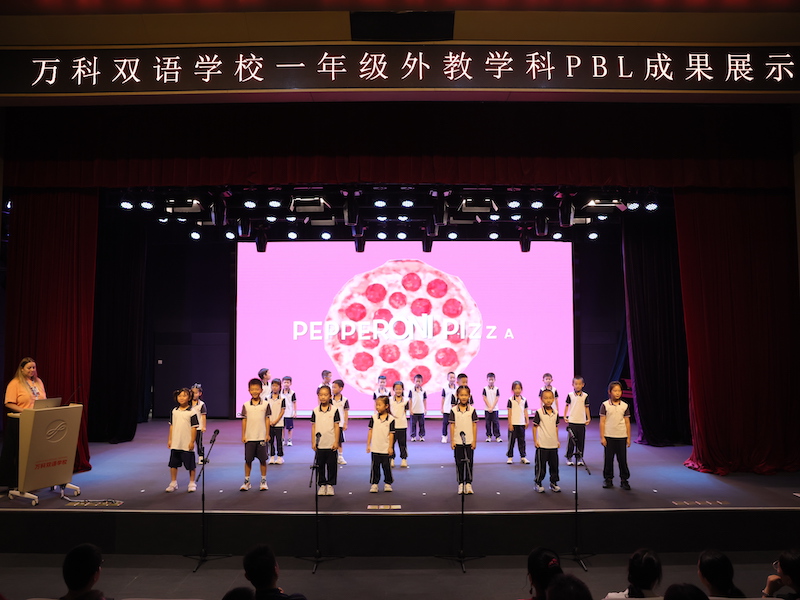
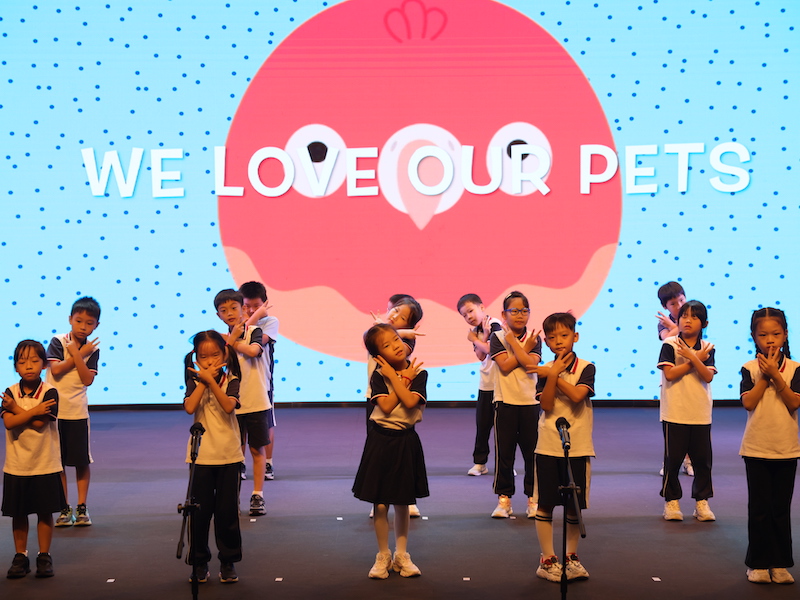
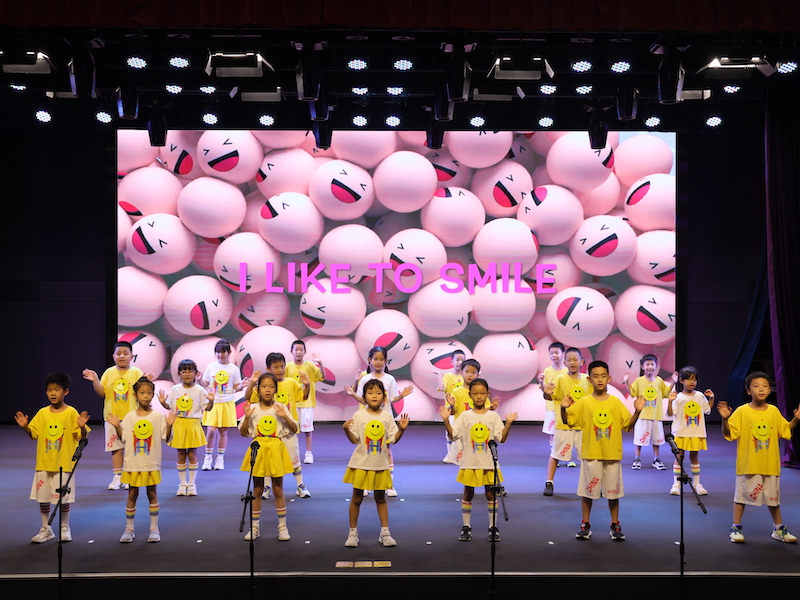
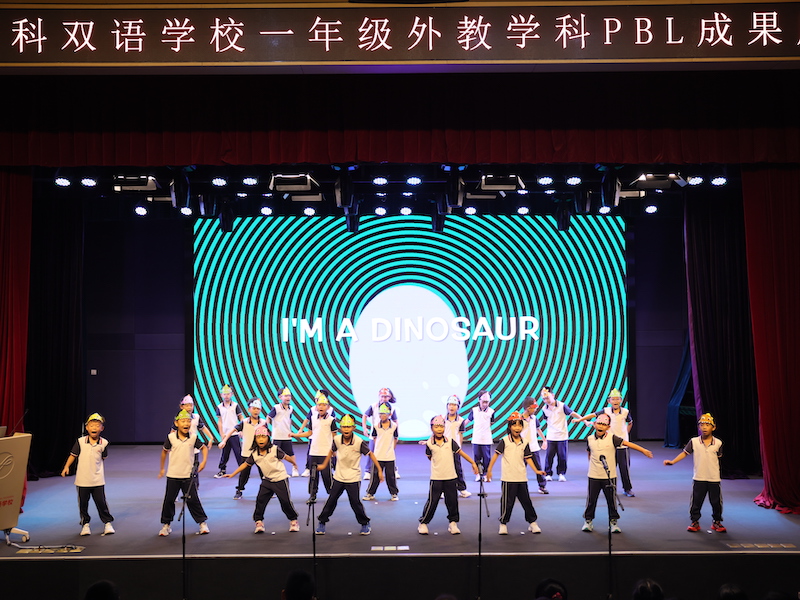
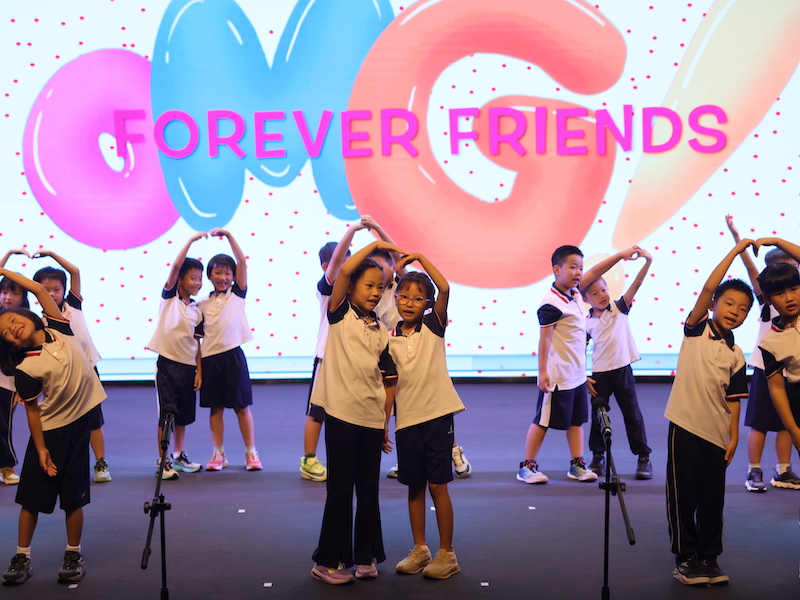
三、海洋探索馆:一年级海洋探索家项目成果发布会
III. Ocean Exploration Hall: Grade 1 Young Explorers Project Showcase
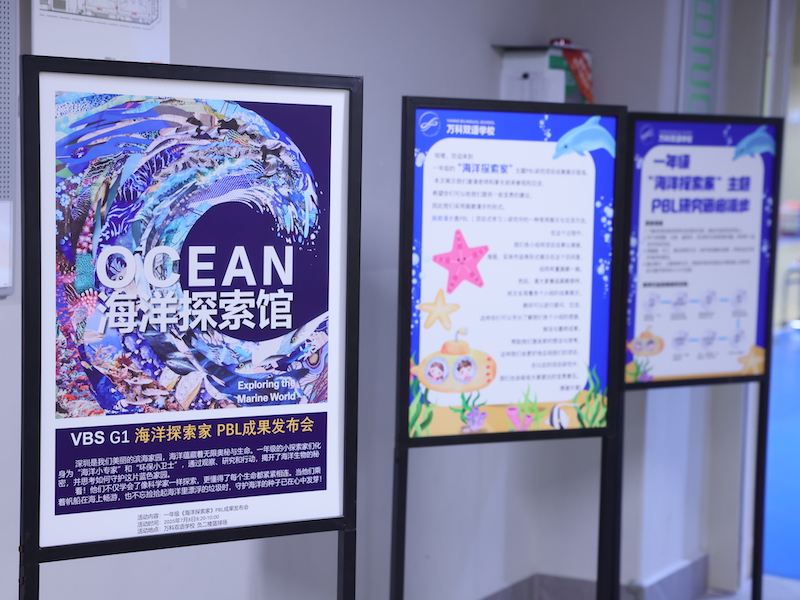
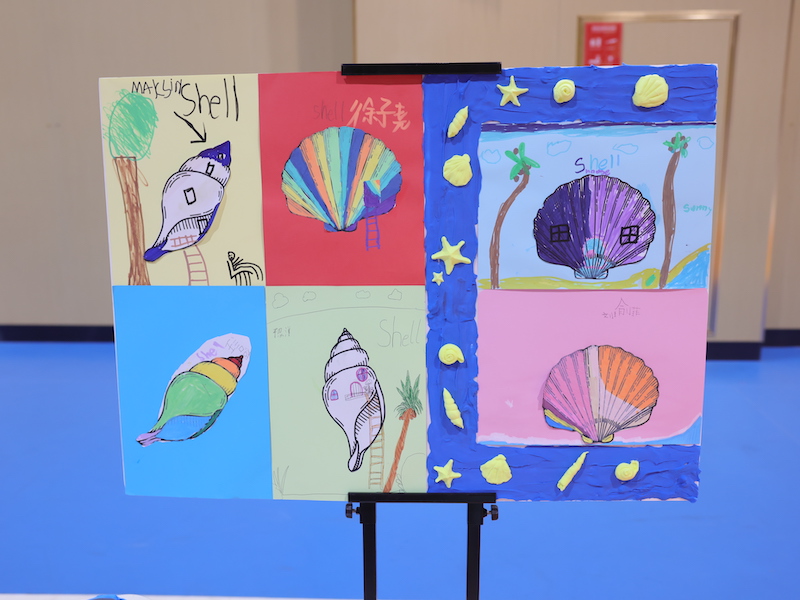
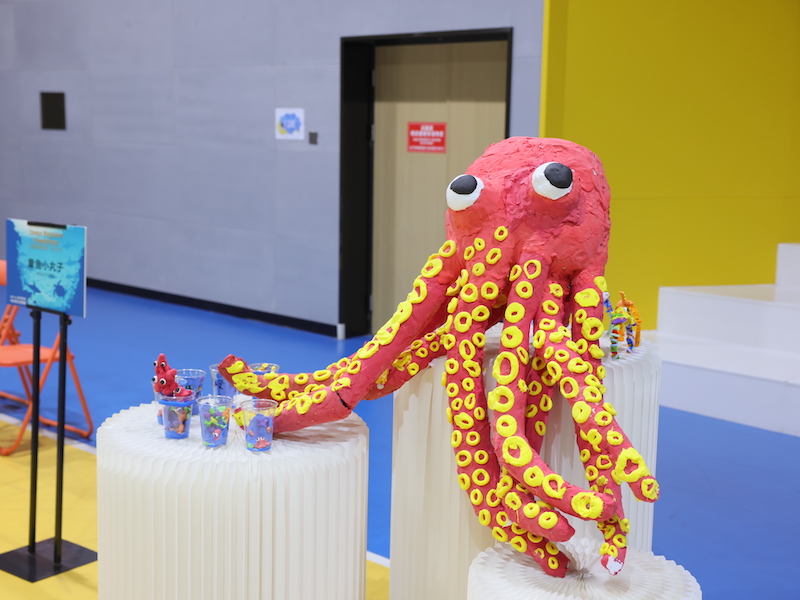
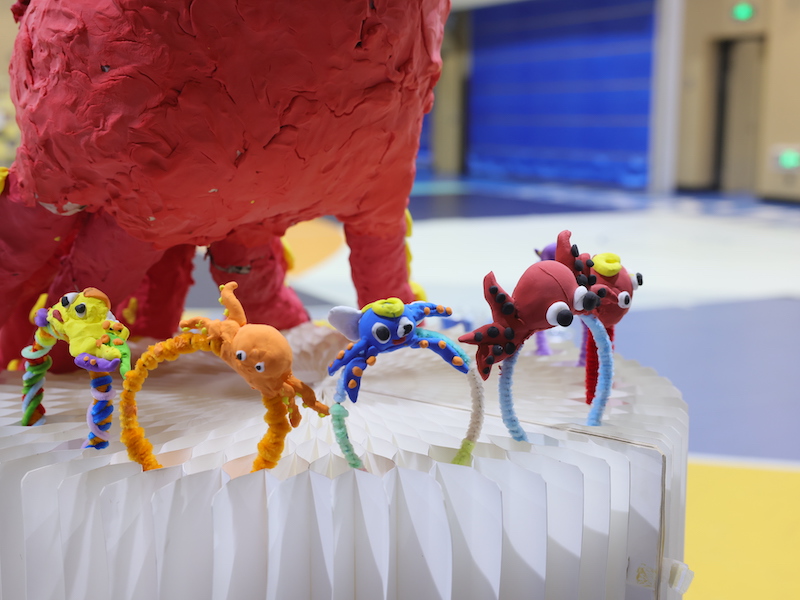
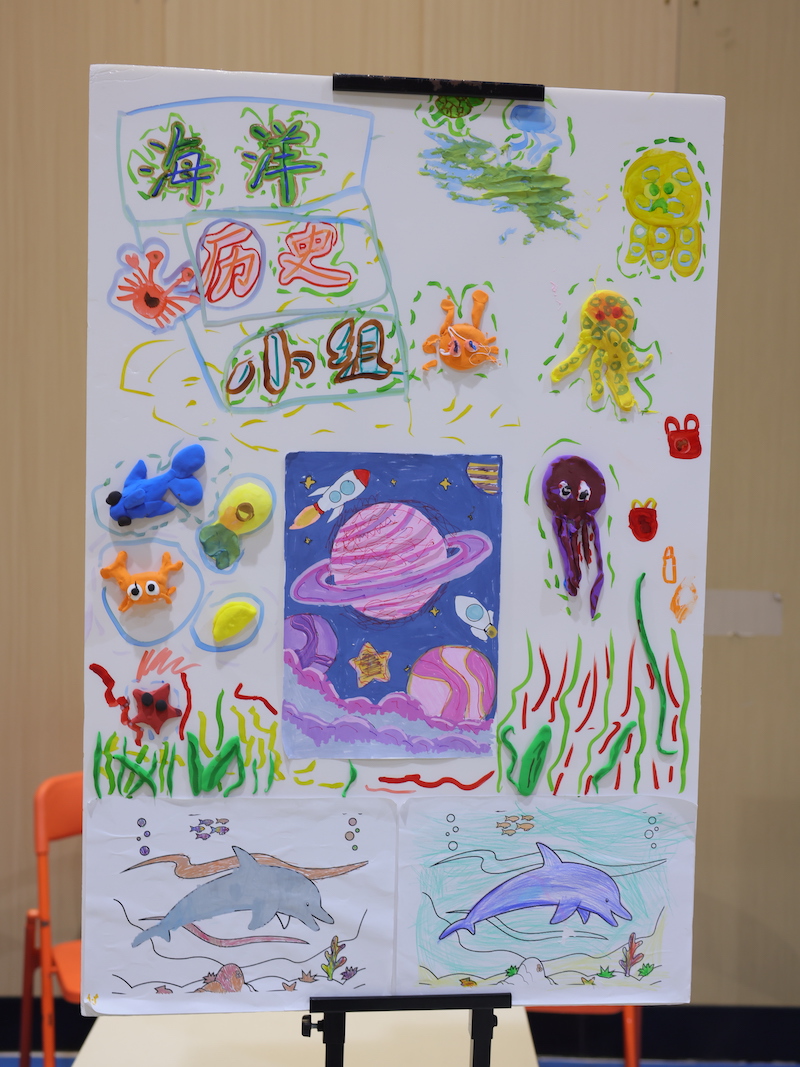
年级组长余丹老师整体介绍了一年级PBL研究的情况:万双竭尽全力呵护孩子们的好奇心,守护他们对世界的热爱。我们通过丰富的课程和活动让孩子们喜欢自己,喜欢同伴,喜欢老师,喜欢班级,喜欢学校。其中PBL课程是万双课程体系中很重要的部分,它不仅是一种教与学方式,也是孩子们参与体验世界的方式。PBL打破了学科之间的分割,打通了孩子的学习与实际生活的联系,通过自主探究、小组合作、成果展示等七个步骤,对自己感兴趣的问题进行深度的学习和研究。孩子们在学习过程中,不仅收获了知识,也提升了各种能力,感受到了学习的快乐,点燃了孩子们学习的热情。
Ms. Yu Dan, the Grade Level Leader, introduced the Grade 1 PBL program: “Vanke Bilingual School is dedicated to nurturing children’s curiosity and safeguarding their love for the world. Our rich curriculum and activities help children appreciate themselves, their peers, teachers, class, and the school. PBL is a vital part of our curriculum—it’s not just a teaching method, but a way for children to experience the world. It breaks down subject barriers, connects learning with real life, and guides students through the seven important steps (inquiry, collaboration, presentation, etc.) to deeply explore topics of interest. Children gain knowledge, enhance various skills, experience the joy of learning, and ignite their passion.”
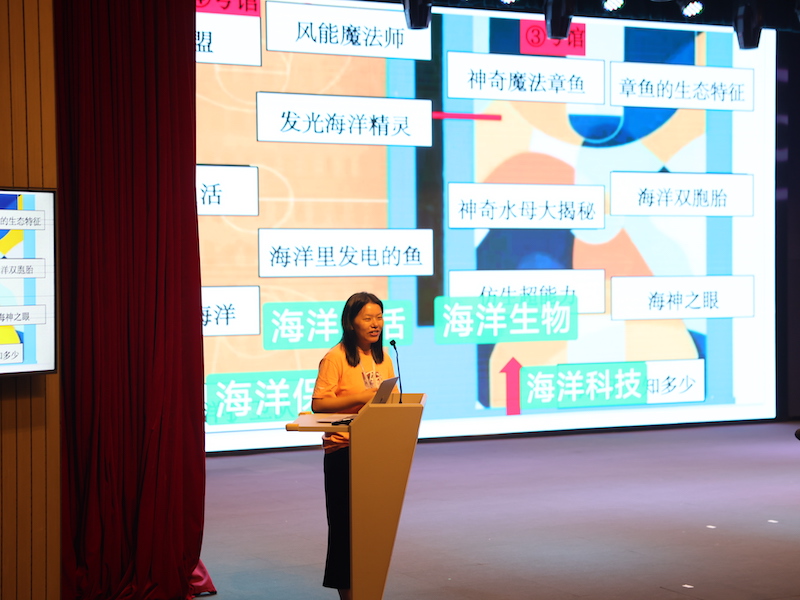
紧接着,家长们跟随海洋展览馆各位小讲解员、引导员们来到负二楼篮球馆进入海洋探索馆。孩子们分成A、B两组,一组介绍成果,另一组带领家长体验。在欢快的音乐声中,孩子们热情洋溢地向家长们展示他们的研究成果,家长们也积极参与其中,现场气氛热烈。
Parents followed students to the Ocean Exploration Hall set up in the B2 Gymnasium. Divided into Groups A and B, children alternated roles: one group presented their research findings while the other led parents through some interactive experiences. Accompanied by cheerful music, children enthusiastically shared their discoveries, with parents actively participating in the vibrant atmosphere.
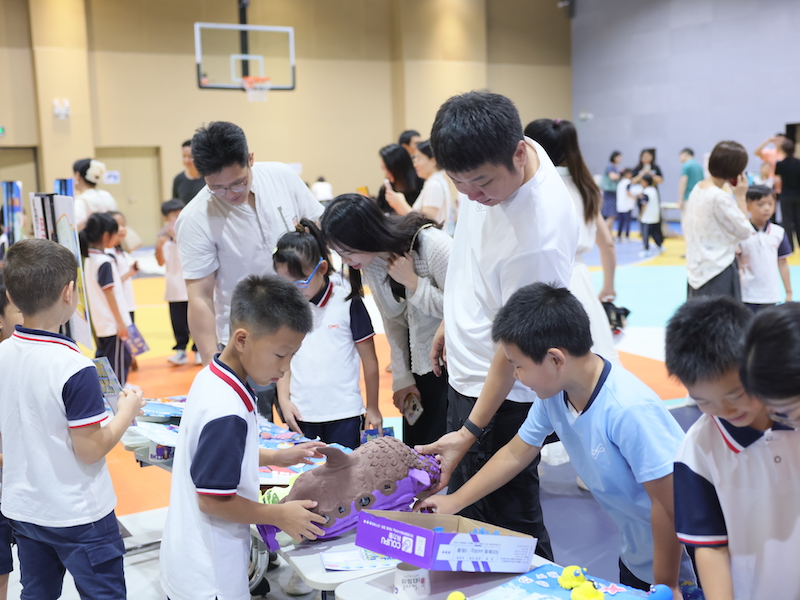
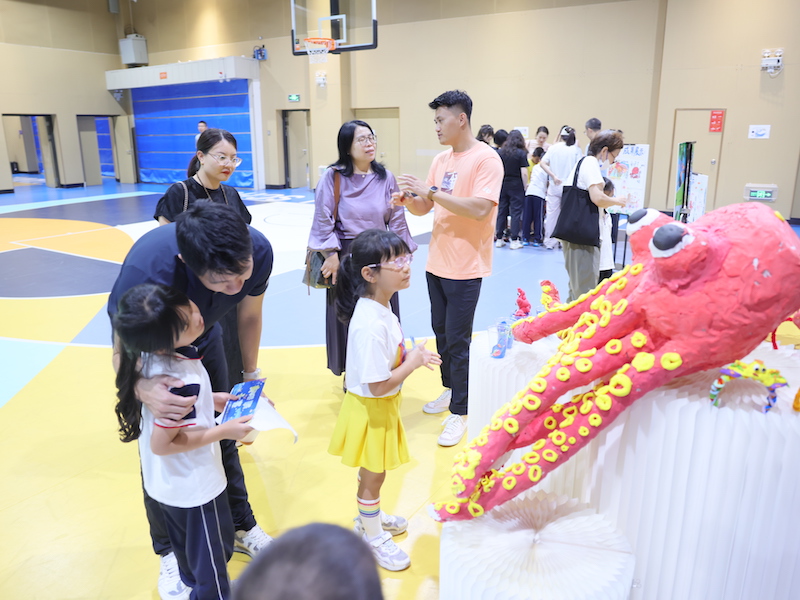
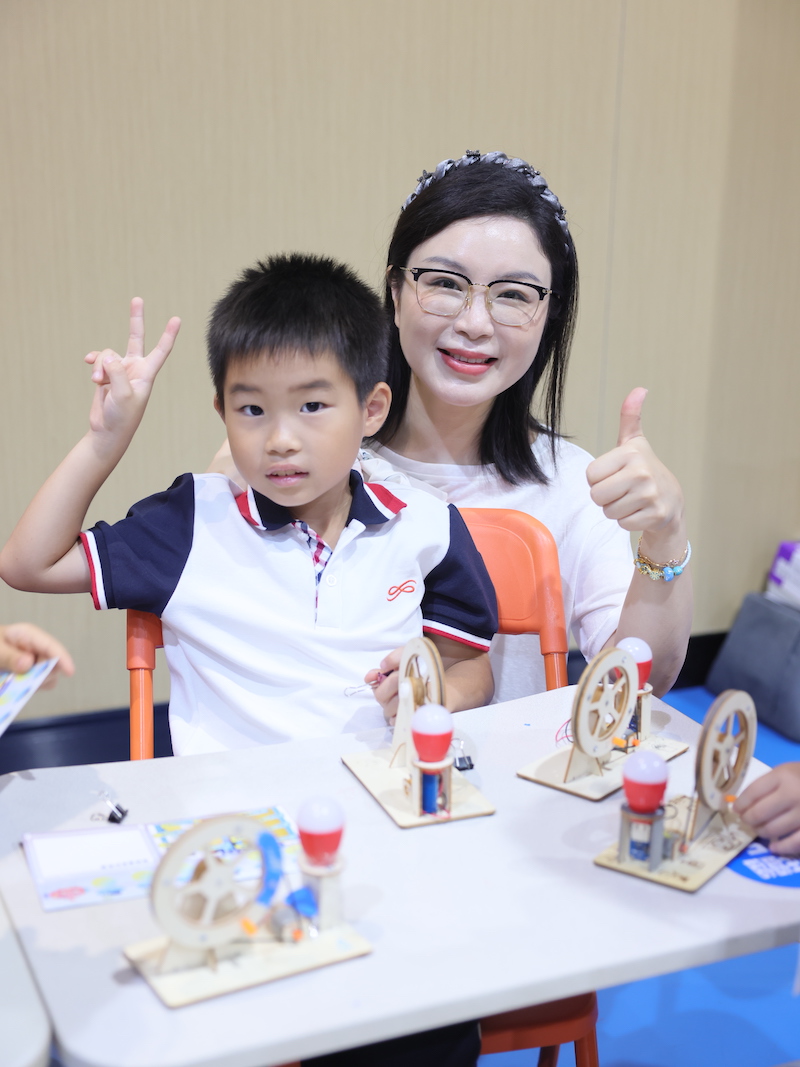
四、共话成长·教育研讨会
IV. Growing Together: Education Symposium
最后,活动进入“共话成长·教育研讨会”环节。家长们回到一年级各班教室分组入座。班主任和学科老师们分别从孩子们这一年的成长点滴,一二年级孩子的变化及心理特点,下一步计划及家校合作等方面进行了深入的分享,展示了孩子们一个学期的学习成果,与家长们共同分享孩子成长的成就与快乐。
The event concluded with the “Growing Together: Education Symposium.” Parents returned to their children’s homerooms for in-depth discussions. Homeroom and subject teachers shared insights on:
Children’s developmental milestones over the year
Key changes and psychological characteristics of Grade 1-2 students
Plans and more collaboration strategies between parents and the school
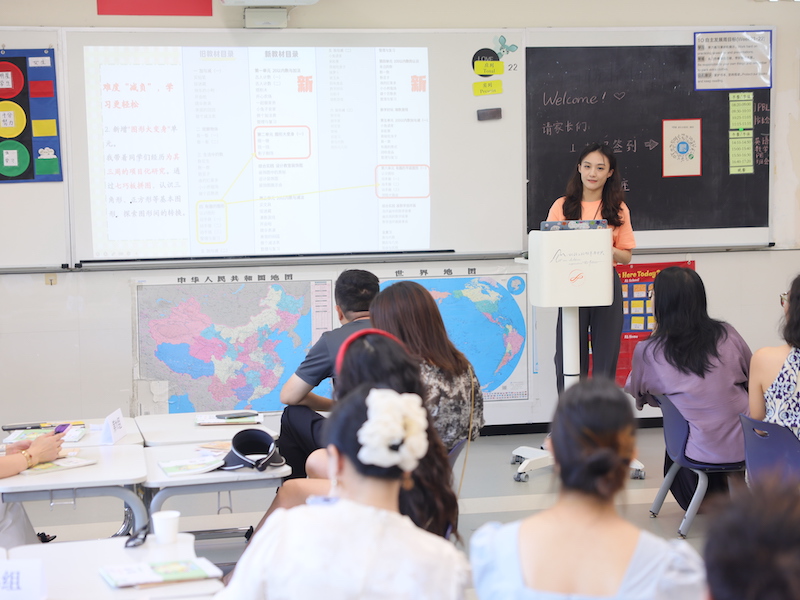
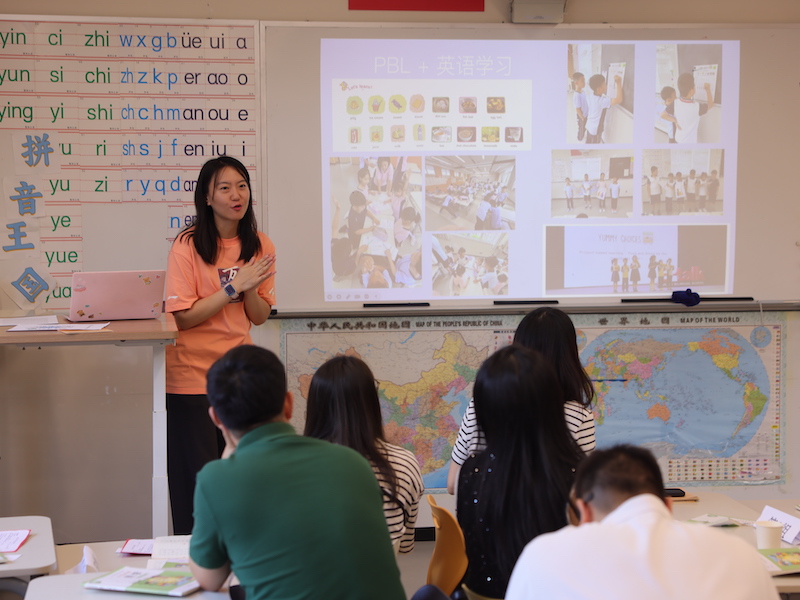
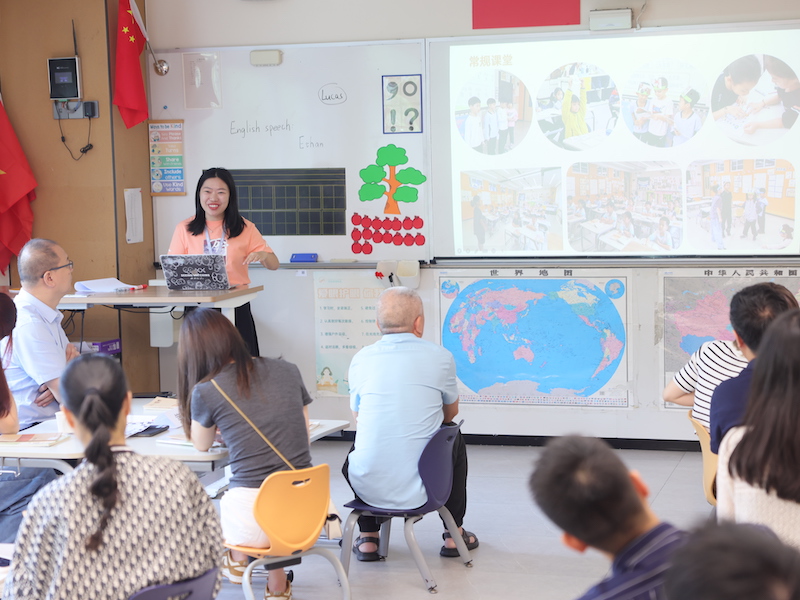
经过前期的问卷调查,年级组筛选出一年级家长最关心的五个高频家庭教育议题。在现场,家长们分组、抽取任务,进行PBL小组研讨并进行小组汇报。整个研讨会过程中,家长们积极发言,分享自己的观点和经验,现场气氛热烈而融洽。通过讨论,一年级的家长们共生了以下智慧:
Based on the pre-event survey, five key parenting topics were identified. Parents then formed Problem-Based Learning (PBL) groups to discuss assigned topics and subsequently presented their collective insights:
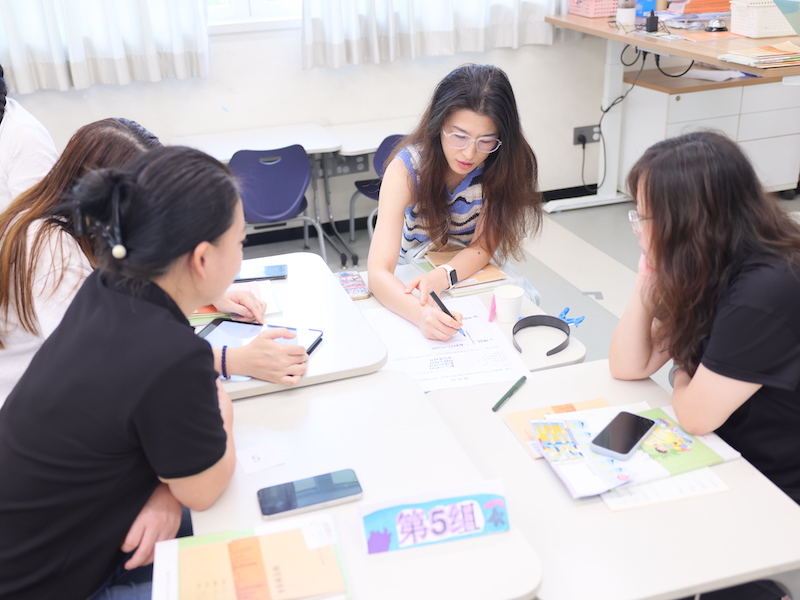
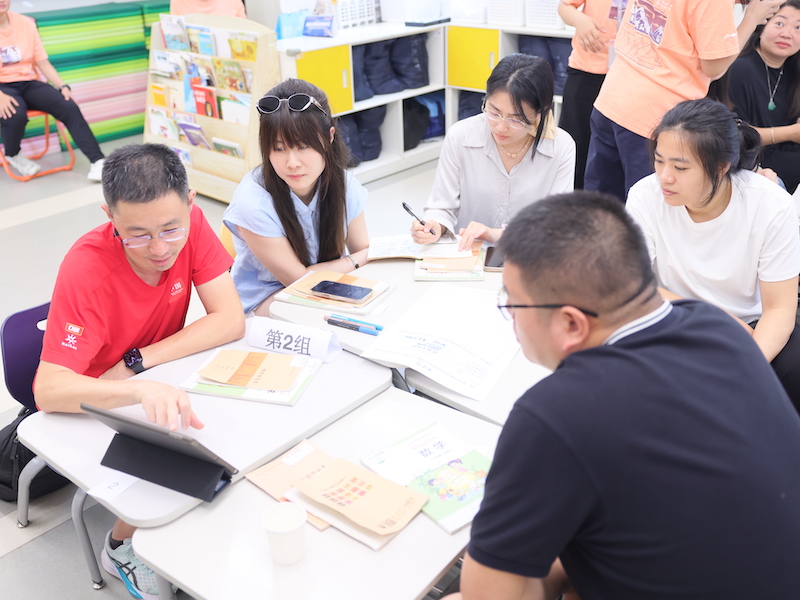
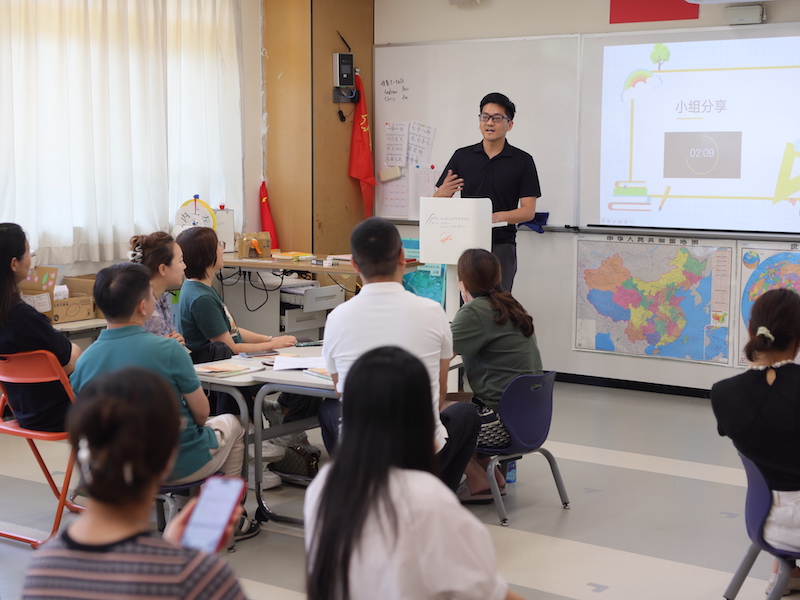
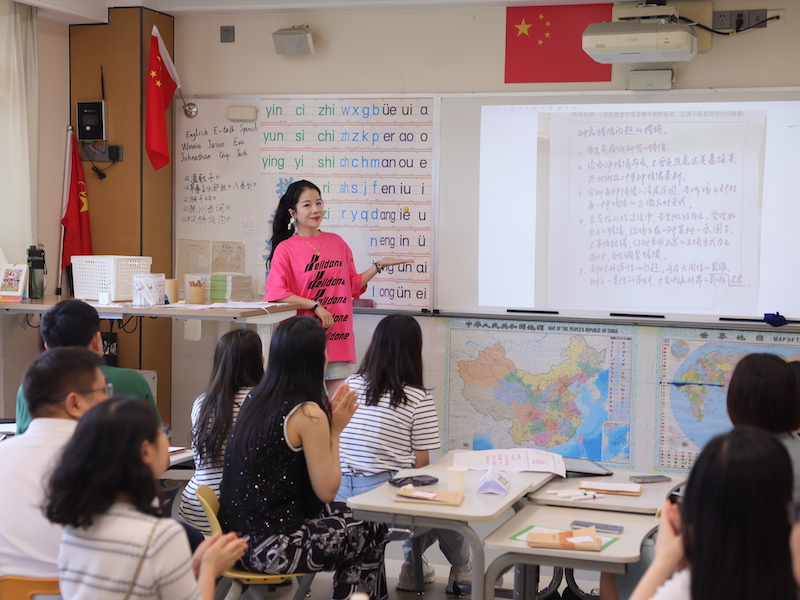
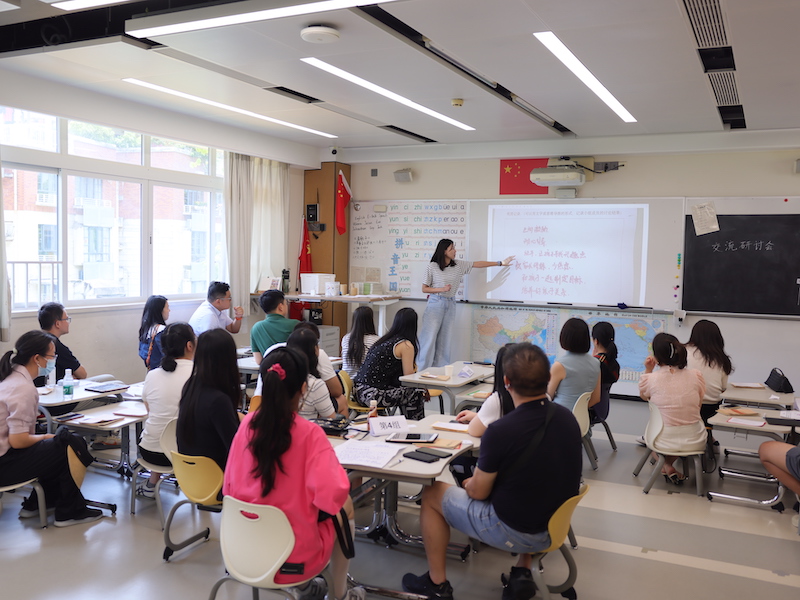
问题一:如何激发孩子的学习内驱力?
1.激发兴趣与成就感:保护孩子的兴趣点,点燃内在的兴趣与好奇心,让孩子感受到“我能行”,体会学习的成就感。
2.自主选择与决策:让孩子拥有自主选择权,参与制定学习计划,培养自主决策能力。
3.营造支持性环境:营造和支持孩子学习的环境,减少代替包办,为孩子提供独立的学习空间。
4.正向激励与反馈:给予正向激励,及时肯定孩子的进步;避免与他人比较,适时口头奖励,以免破坏内驱力。
5.面对挫折与失败:教育孩子面对挫折和失败,帮助他们建立正确的心态,学会从失败中学习。
6.时间管理与目标设定:建立良好的时间管理习惯,共同制定目标与行动计划,培养孩子的自律性。
7.以身作则:家长以身作则,树立榜样,通过自身的行动影响孩子。
8.游戏化学习:设计合理有趣的游戏性学习,赋予学习意义,让孩子在玩中学。
9.追求梦想:鼓励孩子去追求自己的梦想,支持他们的兴趣爱好,帮助他们找到学习的内在动机。
Topic 1: How to Cultivate Children’s Intrinsic Motivation for Learning?
Spark interest and build confidence: Protect their curiosities, ignite internal interests, and let them experience the satisfaction of the phrase:“I can do it!”
Foster autonomy: Grant choices in learning plans and decision-making.
Create supportive environments by providing dedicated learning spaces and avoiding over-managing.
Use positive reinforcement: offer timely praise, avoid comparisons, and use verbal rewards wisely.
Teach resilience: Help them learn to embrace setbacks and grow from failure.
Develop time management & goal setting: Co-create plans to build self-discipline.
Model lifelong learning: Leading by example.
Gamify learning: Design meaningful, play-based activities.
Support passions: Encourage the pursuit of dreams to find internal drive.
问题二:如何帮助孩子养成良好的学习习惯和生活习惯,让孩子能自主自律?
1.榜样的力量:家长以身作则,树立良好的习惯榜样,成为孩子的引路人。
2.制订规则与计划:共同制定规则与行动计划,让孩子参与其中,增强责任感。
3.正向引导与激励:采用正向引导,给予孩子正向激励,避免负面批评。
4.自主学习与自律:培养孩子的自主学习能力,减少代替包办,增强自律性。
5.规律作息:建立规律的生活作息,帮助孩子养成良好的生活习惯。
6.寓教于乐:通过有趣的方式进行教育,如亲子共读、户外活动等,让孩子在快乐中学习。
7.承担后果:让孩子自己承担行为的后果,学会对自己的行为负责。
8.关注兴趣:支持孩子的兴趣爱好,让孩子在感兴趣的领域中培养学习习惯。
9.亲子互动:增加亲子互动时间,如一起做家务、参加活动等,培养孩子的责任感和自主性。
10.独立空间:为孩子提供独立的学习空间和生活空间,减少干扰,提高学习效率。
Topic 2: How to Help Children Develop Good Learning & Living Habits by being Self-Disciplined?
Model desired habits: Be a positive role model.
Co-create rules & plans: Involve children in order to boost responsibility.
Use positive guidance: Focusing on encouragement, not criticism.
Promote independence: Reduce over-assistance; build self-regulation.
Establish routines: Maintain consistent daily schedules.
Make it fun: Use enjoyable methods, for example, shared reading or outdoor activities.
Allow natural consequences: Let children experience the outcome responsibly.
Leverage interests: Connect habit-building to their passions.
Increase family interaction: Sharing chores or activities to build responsibility.
Provide dedicated spaces: Create a quiet study and living area.
问题三:家长怎样根据孩子的情况,扮演好自己的角色?
1.了解孩子:了解孩子的特点和需求,观察孩子的兴趣和行为,做到因材施教。
2.顺其自然:尊重孩子的个性,顺其自然地陪伴成长,不强迫孩子做不喜欢的事情。
3.减少比较:避免过度比较,每个孩子都有自己的特点和优势,不要用别人的标准衡量孩子。
4.耐心陪伴:多点耐心,给孩子成长的空间,不要急于求成。
5.以身作则:家长要不断自我成长,提升认知边界,成为孩子的榜样。
6.直面焦虑:直面自身的焦虑,不要将焦虑传递给孩子,保持积极的心态。
7.发现亮点:发现孩子的亮点和优势,找到自己能接受的下限,相信孩子未来拥有无限可能。
8.增加陪伴:增加陪伴时间,多与孩子互动,参加户外活动和兴趣班,丰富孩子课余生活。
9.合理规划:为孩子制定合理的假期规划,鼓励孩子多做感兴趣的事情,如体育锻炼、阅读等。
10.适度放手:放手让孩子自己做决定,培养他们的独立性和自主性。
Topic 3: How Can Parents Understand and Fulfill Their Role for Their Child?
Know your child: Observe their interests and tailor approaches.
Respect individuality: Support natural growth paths; avoid forcing interests.
Avoid comparisons: Recognize unique strengths.
Practice patience: Allow children space for development.
Grow yourself: Continuously learn to be a better guide.
Manage your anxiety: Do not transfer stress to children.
Focus on strengths: Identify and celebrate their unique qualities.
Prioritize connection: Increase quality time and shared experiences.
Plan wisely: Structure holidays with enriching activities (sports, reading).
Encourage independence: Let them make age-appropriate choices.
问题四:如何处理应对小朋友的情绪问题?引导孩子管理情绪的办法有哪些?
1.接纳情绪:接纳孩子的情绪,不否定也不压制,让孩子感受到被理解。
2.共情与倾听:共情孩子的委屈,聆听他们的需求,给予正向反馈,建立安全感。
3.情绪识别与表达:帮助孩子识别和表达情绪,引导他们说出自己的感受。
4.引导释放情绪:引导孩子用合适方式释放情绪,如哭泣、倾诉等,避免伤害自己或他人。
5.保持冷静:家长要保持冷静,做好示范,避免情绪失控。
6.情绪命名:给孩子的情绪命名,如挫败感、焦虑等,帮助他们理解情绪。
7.分析原因:分析情绪的深层原因,引导孩子找到解决问题的方法。
8.转移注意力:通过转移注意力、回忆复述等方式,帮助孩子跳出情绪困境。
9.建立规则:建立情绪管理的规则,让孩子知道如何正确应对情绪。
10.陪伴与耐心:平时多陪伴孩子,多耐心,让孩子感受到家长的支持。
Topic 4: How to Help Children Manage Their Emotions?
Validate feelings: Acknowledge emotions without judging.
Empathize and listen: Understand their perspective; provide security.
Teach emotional literacy: Help identify and describe feelings.
Guide healthy expression: Suggest safe spaces and activities (talking, drawing).
Stay calm: Model emotional regulation.
Name emotions: Help them understand complex feelings (e.g., frustration).
Explore causes: Discuss triggers and solutions together.
Redirect focus: Use distraction or reflection to shift the mood.
Set boundaries: Establish clear emotional management rules.
Be present: Offer consistent support and patience.
问题五:如何管理孩子的电子产品?
1.制定规则:制定明确的电子产品使用规则,控制使用时间,避免过度沉迷。
2.内容筛选:优先选择健康、有益的内容,如新闻实事类、英语动画片、纪录片等。
3.增加互动:增加亲子互动时间,如户外活动、家庭游戏等,减少孩子对电子产品的依赖。
4.以身作则:家长以身作则,减少自己对电子产品的过度使用,为孩子树立榜样。
5.替代活动:鼓励孩子参与其他活动,如阅读、绘画、体育锻炼等,培养孩子的多元兴趣。
6.时间管理:通过闹钟提醒、密码控制等方式,帮助孩子养成良好的时间管理习惯。
7.共同观看:抽时间和孩子一起观看电子产品内容,增加互动,引导孩子正确理解和使用。
8.暑假规划:暑假期间提前规划,鼓励孩子多做感兴趣的事情,避免长时间沉迷电子产品。
9.坚持原则:坚持原则,明确哪些内容可以看,哪些是禁止的,避免孩子接触不健康的内容。
10.寻找玩伴:为孩子找一个玩伴,增加社交互动,减少对电子产品的依赖。
Topic 5: How to Manage Children's Screen Time?
Set clear rules: Limit duration and prevent overuse.
Curate content: Prioritize educational material (news, documentaries).
Increase interaction: Replace screen time with family activities or outdoors.
Model restraint: Reduce your device usage.
Offer alternatives: Encourage hobbies (reading, sports, art).
Use timers or controls: Employ tools to build time awareness.
Co-view content: Watch together to guide understanding.
Plan holidays: Structure breaks with engaging offline activities.
Enforce boundaries: Consistently uphold content restrictions.
Facilitate playdates: Encourage social interaction over solitary screen time.
通过本次期末PBL展示及家长会活动,孩子们不仅展示了他们的学习成果,更锻炼了自己的表达能力和团队协作能力。家长们也对学校的教育教学工作有了更深入的了解,对孩子们的成长有了更清晰的认识。家长们纷纷表示这次家长会活动让他们收获满满。这一年,孩子们在万双的成长格外丰富:不仅汲取了知识的养分,各项能力也在实践中稳步提升。更珍贵的是,他们每天都满心期待地走进校园,对学习怀揣热忱,在万双的每一天都充盈着快乐。这份成长离不开家校之间的默契协作。未来,我们将继续携手同行,用爱与责任共同守护每一位孩子,让他们健康快乐地站在未来中央。
Through this PBL showcase and parents meeting, children demonstrated their learning achievements while honing their presentation and teamwork skills. Parents gained deeper insights into the school's educational approach and their children's development. Many expressed how rewarding the event was. This year at Vanke Bilingual School, children have flourished remarkably: absorbing knowledge, steadily enhancing their abilities through practice, and—most importantly—entering the campus each day with eager anticipation and a joy for learning. This growth stems from the seamless partnership between parents and the school. Moving forward, we remain committed to walking hand-in-hand, protecting every child with love and responsibility, ensuring they stand healthy, happy, and confident at the heart of the future.
资料提供/ 蔡倩如
翻译/ 黄巧莉
排版/ 马葳
万双网讯 2025年7月8日上午,一年级全体师生及家长齐聚校园,共同参与了一场别开生面的期末PBL展示暨家长会活动。本次活动旨在通过多元化的展示形式,呈现孩子们本学期的学习成果,同时搭建家校沟通的桥梁,促进学生全面发展。
On the morning of July 8th, 2025, all Grade 1 students, teachers, and parents gathered on campus to participate in a unique end-of-term Project-Based Learning (PBL) presentation and parent meeting. This event aimed to present the children’s learning achievements through diverse presentation formats while building a bridge for communication between the school and parents.
一、图形和英语的魔法世界:数学英语学科PBL成果展
I. The Magical World of Shapes and English: Math & English PBL Exhibition
活动伊始,当家长们步入校园,目光便不由自主地被孩子们精心打造的语数英学科PBL成果展所吸引。各班级的展示区里,孩子们的学习过程和成果被巧妙地呈现出来,充满了童趣与创意。家长们在欣赏孩子们作品的同时,也感受到了孩子们在学习过程中的成长与进步。
As parents entered the campus, they were immediately drawn to the meticulously crafted Math and English PBL exhibitions. Each classroom’s display area showcased children’s learning processes and outcomes with their creativity and childlike charm. While appreciating the children’s work, parents witnessed their children’s growth and progress throughout their learning journey.



二、Things we like:外教学科PBL成果展示
II. Things We Like: Foreign Teachers’ PBL Showcase
随后,活动移步至剧场,进入“星光璀璨·外教学科 PBL 成果展示”环节。主持人精彩的开场白拉开了序幕,孩子们依次上台进行节目表演,充分展示了他们在外教学科 PBL学习中的收获与风采。
The event then moved to the theater for the “Spotlight: Foreign Teachers’ PBL Showcase.” An engaging opening by the hosts set the stage for the children’s performances, fully demonstrating their achievements and confidence gained through foreign teachers’PBL activities.
首先出场的1X班,在舞台上,孩子们自信表演了一首《I like sing O》,赢得了家长们阵阵掌声。其次出场的是1G 班,一首《Pepperoni Pizza》,舞台上孩子们大方自然,跳出了风采。紧接着出场的是1C班他们带来的《I Love Our Pets》尽显自信大方。随后登上舞台的是1I班,《I Love Smile》表演中,孩子们胸前贴着笑脸,脸上绽放出灿烂的微笑。再之后是1O班的《I’m a Dinosaur》,孩子们头戴恐龙头套,像小恐龙一样跳舞。最后出场的是1E班,孩子们手拉手出场,表演《Forever Friends》。表演尾声,他们两两一组向观众比出爱心,用肢体语言诠释着 “永远的好朋友” 的真谛。
Class 1X confidently performed ‘I Like Sing O’, earning warm applause. Class 1G followed with ‘Pepperoni Pizza’, showcasing their natural flair on stage. Class 1C radiated self-assurance during their performance of ‘We Love Our Pets’. Class 1I returned with ‘I Love “Smile”’, with children beaming their bright smiles and wearing smiley stickers. Class 1O captivated the audience with ‘I am a Dinosaur’, dancing energetically in dinosaur headgear. Class 1E concluded the performances hand-in-hand with ‘Forever Friends’, forming heart shapes in pairs to embody the song’s message.





三、海洋探索馆:一年级海洋探索家项目成果发布会
III. Ocean Exploration Hall: Grade 1 Young Explorers Project Showcase





年级组长余丹老师整体介绍了一年级PBL研究的情况:万双竭尽全力呵护孩子们的好奇心,守护他们对世界的热爱。我们通过丰富的课程和活动让孩子们喜欢自己,喜欢同伴,喜欢老师,喜欢班级,喜欢学校。其中PBL课程是万双课程体系中很重要的部分,它不仅是一种教与学方式,也是孩子们参与体验世界的方式。PBL打破了学科之间的分割,打通了孩子的学习与实际生活的联系,通过自主探究、小组合作、成果展示等七个步骤,对自己感兴趣的问题进行深度的学习和研究。孩子们在学习过程中,不仅收获了知识,也提升了各种能力,感受到了学习的快乐,点燃了孩子们学习的热情。
Ms. Yu Dan, the Grade Level Leader, introduced the Grade 1 PBL program: “Vanke Bilingual School is dedicated to nurturing children’s curiosity and safeguarding their love for the world. Our rich curriculum and activities help children appreciate themselves, their peers, teachers, class, and the school. PBL is a vital part of our curriculum—it’s not just a teaching method, but a way for children to experience the world. It breaks down subject barriers, connects learning with real life, and guides students through the seven important steps (inquiry, collaboration, presentation, etc.) to deeply explore topics of interest. Children gain knowledge, enhance various skills, experience the joy of learning, and ignite their passion.”

紧接着,家长们跟随海洋展览馆各位小讲解员、引导员们来到负二楼篮球馆进入海洋探索馆。孩子们分成A、B两组,一组介绍成果,另一组带领家长体验。在欢快的音乐声中,孩子们热情洋溢地向家长们展示他们的研究成果,家长们也积极参与其中,现场气氛热烈。
Parents followed students to the Ocean Exploration Hall set up in the B2 Gymnasium. Divided into Groups A and B, children alternated roles: one group presented their research findings while the other led parents through some interactive experiences. Accompanied by cheerful music, children enthusiastically shared their discoveries, with parents actively participating in the vibrant atmosphere.



四、共话成长·教育研讨会
IV. Growing Together: Education Symposium
最后,活动进入“共话成长·教育研讨会”环节。家长们回到一年级各班教室分组入座。班主任和学科老师们分别从孩子们这一年的成长点滴,一二年级孩子的变化及心理特点,下一步计划及家校合作等方面进行了深入的分享,展示了孩子们一个学期的学习成果,与家长们共同分享孩子成长的成就与快乐。
The event concluded with the “Growing Together: Education Symposium.” Parents returned to their children’s homerooms for in-depth discussions. Homeroom and subject teachers shared insights on:
Children’s developmental milestones over the year
Key changes and psychological characteristics of Grade 1-2 students
Plans and more collaboration strategies between parents and the school



经过前期的问卷调查,年级组筛选出一年级家长最关心的五个高频家庭教育议题。在现场,家长们分组、抽取任务,进行PBL小组研讨并进行小组汇报。整个研讨会过程中,家长们积极发言,分享自己的观点和经验,现场气氛热烈而融洽。通过讨论,一年级的家长们共生了以下智慧:
Based on the pre-event survey, five key parenting topics were identified. Parents then formed Problem-Based Learning (PBL) groups to discuss assigned topics and subsequently presented their collective insights:





问题一:如何激发孩子的学习内驱力?
1.激发兴趣与成就感:保护孩子的兴趣点,点燃内在的兴趣与好奇心,让孩子感受到“我能行”,体会学习的成就感。
2.自主选择与决策:让孩子拥有自主选择权,参与制定学习计划,培养自主决策能力。
3.营造支持性环境:营造和支持孩子学习的环境,减少代替包办,为孩子提供独立的学习空间。
4.正向激励与反馈:给予正向激励,及时肯定孩子的进步;避免与他人比较,适时口头奖励,以免破坏内驱力。
5.面对挫折与失败:教育孩子面对挫折和失败,帮助他们建立正确的心态,学会从失败中学习。
6.时间管理与目标设定:建立良好的时间管理习惯,共同制定目标与行动计划,培养孩子的自律性。
7.以身作则:家长以身作则,树立榜样,通过自身的行动影响孩子。
8.游戏化学习:设计合理有趣的游戏性学习,赋予学习意义,让孩子在玩中学。
9.追求梦想:鼓励孩子去追求自己的梦想,支持他们的兴趣爱好,帮助他们找到学习的内在动机。
Topic 1: How to Cultivate Children’s Intrinsic Motivation for Learning?
Spark interest and build confidence: Protect their curiosities, ignite internal interests, and let them experience the satisfaction of the phrase:“I can do it!”
Foster autonomy: Grant choices in learning plans and decision-making.
Create supportive environments by providing dedicated learning spaces and avoiding over-managing.
Use positive reinforcement: offer timely praise, avoid comparisons, and use verbal rewards wisely.
Teach resilience: Help them learn to embrace setbacks and grow from failure.
Develop time management & goal setting: Co-create plans to build self-discipline.
Model lifelong learning: Leading by example.
Gamify learning: Design meaningful, play-based activities.
Support passions: Encourage the pursuit of dreams to find internal drive.
问题二:如何帮助孩子养成良好的学习习惯和生活习惯,让孩子能自主自律?
1.榜样的力量:家长以身作则,树立良好的习惯榜样,成为孩子的引路人。
2.制订规则与计划:共同制定规则与行动计划,让孩子参与其中,增强责任感。
3.正向引导与激励:采用正向引导,给予孩子正向激励,避免负面批评。
4.自主学习与自律:培养孩子的自主学习能力,减少代替包办,增强自律性。
5.规律作息:建立规律的生活作息,帮助孩子养成良好的生活习惯。
6.寓教于乐:通过有趣的方式进行教育,如亲子共读、户外活动等,让孩子在快乐中学习。
7.承担后果:让孩子自己承担行为的后果,学会对自己的行为负责。
8.关注兴趣:支持孩子的兴趣爱好,让孩子在感兴趣的领域中培养学习习惯。
9.亲子互动:增加亲子互动时间,如一起做家务、参加活动等,培养孩子的责任感和自主性。
10.独立空间:为孩子提供独立的学习空间和生活空间,减少干扰,提高学习效率。
Topic 2: How to Help Children Develop Good Learning & Living Habits by being Self-Disciplined?
Model desired habits: Be a positive role model.
Co-create rules & plans: Involve children in order to boost responsibility.
Use positive guidance: Focusing on encouragement, not criticism.
Promote independence: Reduce over-assistance; build self-regulation.
Establish routines: Maintain consistent daily schedules.
Make it fun: Use enjoyable methods, for example, shared reading or outdoor activities.
Allow natural consequences: Let children experience the outcome responsibly.
Leverage interests: Connect habit-building to their passions.
Increase family interaction: Sharing chores or activities to build responsibility.
Provide dedicated spaces: Create a quiet study and living area.
问题三:家长怎样根据孩子的情况,扮演好自己的角色?
1.了解孩子:了解孩子的特点和需求,观察孩子的兴趣和行为,做到因材施教。
2.顺其自然:尊重孩子的个性,顺其自然地陪伴成长,不强迫孩子做不喜欢的事情。
3.减少比较:避免过度比较,每个孩子都有自己的特点和优势,不要用别人的标准衡量孩子。
4.耐心陪伴:多点耐心,给孩子成长的空间,不要急于求成。
5.以身作则:家长要不断自我成长,提升认知边界,成为孩子的榜样。
6.直面焦虑:直面自身的焦虑,不要将焦虑传递给孩子,保持积极的心态。
7.发现亮点:发现孩子的亮点和优势,找到自己能接受的下限,相信孩子未来拥有无限可能。
8.增加陪伴:增加陪伴时间,多与孩子互动,参加户外活动和兴趣班,丰富孩子课余生活。
9.合理规划:为孩子制定合理的假期规划,鼓励孩子多做感兴趣的事情,如体育锻炼、阅读等。
10.适度放手:放手让孩子自己做决定,培养他们的独立性和自主性。
Topic 3: How Can Parents Understand and Fulfill Their Role for Their Child?
Know your child: Observe their interests and tailor approaches.
Respect individuality: Support natural growth paths; avoid forcing interests.
Avoid comparisons: Recognize unique strengths.
Practice patience: Allow children space for development.
Grow yourself: Continuously learn to be a better guide.
Manage your anxiety: Do not transfer stress to children.
Focus on strengths: Identify and celebrate their unique qualities.
Prioritize connection: Increase quality time and shared experiences.
Plan wisely: Structure holidays with enriching activities (sports, reading).
Encourage independence: Let them make age-appropriate choices.
问题四:如何处理应对小朋友的情绪问题?引导孩子管理情绪的办法有哪些?
1.接纳情绪:接纳孩子的情绪,不否定也不压制,让孩子感受到被理解。
2.共情与倾听:共情孩子的委屈,聆听他们的需求,给予正向反馈,建立安全感。
3.情绪识别与表达:帮助孩子识别和表达情绪,引导他们说出自己的感受。
4.引导释放情绪:引导孩子用合适方式释放情绪,如哭泣、倾诉等,避免伤害自己或他人。
5.保持冷静:家长要保持冷静,做好示范,避免情绪失控。
6.情绪命名:给孩子的情绪命名,如挫败感、焦虑等,帮助他们理解情绪。
7.分析原因:分析情绪的深层原因,引导孩子找到解决问题的方法。
8.转移注意力:通过转移注意力、回忆复述等方式,帮助孩子跳出情绪困境。
9.建立规则:建立情绪管理的规则,让孩子知道如何正确应对情绪。
10.陪伴与耐心:平时多陪伴孩子,多耐心,让孩子感受到家长的支持。
Topic 4: How to Help Children Manage Their Emotions?
Validate feelings: Acknowledge emotions without judging.
Empathize and listen: Understand their perspective; provide security.
Teach emotional literacy: Help identify and describe feelings.
Guide healthy expression: Suggest safe spaces and activities (talking, drawing).
Stay calm: Model emotional regulation.
Name emotions: Help them understand complex feelings (e.g., frustration).
Explore causes: Discuss triggers and solutions together.
Redirect focus: Use distraction or reflection to shift the mood.
Set boundaries: Establish clear emotional management rules.
Be present: Offer consistent support and patience.
问题五:如何管理孩子的电子产品?
1.制定规则:制定明确的电子产品使用规则,控制使用时间,避免过度沉迷。
2.内容筛选:优先选择健康、有益的内容,如新闻实事类、英语动画片、纪录片等。
3.增加互动:增加亲子互动时间,如户外活动、家庭游戏等,减少孩子对电子产品的依赖。
4.以身作则:家长以身作则,减少自己对电子产品的过度使用,为孩子树立榜样。
5.替代活动:鼓励孩子参与其他活动,如阅读、绘画、体育锻炼等,培养孩子的多元兴趣。
6.时间管理:通过闹钟提醒、密码控制等方式,帮助孩子养成良好的时间管理习惯。
7.共同观看:抽时间和孩子一起观看电子产品内容,增加互动,引导孩子正确理解和使用。
8.暑假规划:暑假期间提前规划,鼓励孩子多做感兴趣的事情,避免长时间沉迷电子产品。
9.坚持原则:坚持原则,明确哪些内容可以看,哪些是禁止的,避免孩子接触不健康的内容。
10.寻找玩伴:为孩子找一个玩伴,增加社交互动,减少对电子产品的依赖。
Topic 5: How to Manage Children's Screen Time?
Set clear rules: Limit duration and prevent overuse.
Curate content: Prioritize educational material (news, documentaries).
Increase interaction: Replace screen time with family activities or outdoors.
Model restraint: Reduce your device usage.
Offer alternatives: Encourage hobbies (reading, sports, art).
Use timers or controls: Employ tools to build time awareness.
Co-view content: Watch together to guide understanding.
Plan holidays: Structure breaks with engaging offline activities.
Enforce boundaries: Consistently uphold content restrictions.
Facilitate playdates: Encourage social interaction over solitary screen time.
通过本次期末PBL展示及家长会活动,孩子们不仅展示了他们的学习成果,更锻炼了自己的表达能力和团队协作能力。家长们也对学校的教育教学工作有了更深入的了解,对孩子们的成长有了更清晰的认识。家长们纷纷表示这次家长会活动让他们收获满满。这一年,孩子们在万双的成长格外丰富:不仅汲取了知识的养分,各项能力也在实践中稳步提升。更珍贵的是,他们每天都满心期待地走进校园,对学习怀揣热忱,在万双的每一天都充盈着快乐。这份成长离不开家校之间的默契协作。未来,我们将继续携手同行,用爱与责任共同守护每一位孩子,让他们健康快乐地站在未来中央。
Through this PBL showcase and parents meeting, children demonstrated their learning achievements while honing their presentation and teamwork skills. Parents gained deeper insights into the school's educational approach and their children's development. Many expressed how rewarding the event was. This year at Vanke Bilingual School, children have flourished remarkably: absorbing knowledge, steadily enhancing their abilities through practice, and—most importantly—entering the campus each day with eager anticipation and a joy for learning. This growth stems from the seamless partnership between parents and the school. Moving forward, we remain committed to walking hand-in-hand, protecting every child with love and responsibility, ensuring they stand healthy, happy, and confident at the heart of the future.
资料提供/ 蔡倩如
翻译/ 黄巧莉
排版/ 马葳
办学理念:让孩子站在未来中央
培养(成长)目标:培养(成为)身体健康、人格健全、学力卓越,具有家国情怀和国际视野, 敢于创造美好未来的中国公民。
地址:深圳市龙华区民治街道华南路80号
电话:0755-66866333
http://vbs.vanke.com
Vanke Bilingual School, Longhua District, Shenzhen
Educational Idea: Let our children experience the future.
Training objectives: our students will become citizen of China with good physical health, sound personality, excellent academic abilities, patriotism, international vision and the courage to create a better future.
Address: No.80 Huanan Road, Minzhi Sub-district, Longhua District, Shenzhen
Contact: 0755-66866333
http://vbs.vanke.com

学校网站二维码
QR code of school website
学校公众号二维码
QR code of school official account